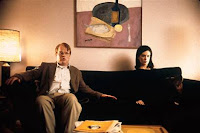 Think of the weirdest thing you’ve ever seen in your life. You might think it was weird, but after seeing “Happiness,” you won’t know what weird is anymore. I don’t say this in a negative way. “Happiness” exceeds any level of strangeness and thus propels itself into its very own, unique category.
Think of the weirdest thing you’ve ever seen in your life. You might think it was weird, but after seeing “Happiness,” you won’t know what weird is anymore. I don’t say this in a negative way. “Happiness” exceeds any level of strangeness and thus propels itself into its very own, unique category.
“Happiness” has no plot, only many characters. The decisions, good and bad, of these characters is what ultimately propels the story forward. It is an ensemble film which contains a sprawling cast. The story focuses on many different New Jersey residents, each who are far from happy. The ensemble includes Allen (Phillip Seymour Hoffman), a lonely man who’s afraid to talk to women, a lonely woman (Jane Adams) who’s afraid of the future, a married therapist (Dylan Baker) with a disturbing secret, a shallow writer (Lara Flynn Boyle), and an old couple who can no longer feel love.
Each character is presented in their own original story at first. Over time, the stories start to overlap, and it is revealed that every character is somehow related. One character is the sibling of another who is friends of another character and neighbors with another. At certain times, you’ll scream in shock to see one character’s unexpected relation with another. But at the same time, it allows you to see another side of each character. A contrast between one or the other, a look at how much deeper their emotions go than we thought we knew.
Yes, the movie is strange and uncomfortable. Conversations are evoked that one would never have in ordinary life, topics I can’t even mention here. However, the awkward moments don’t detract from the story but instead make it better. They turn into little idiosyncrasies that reveal something about each character, whether it is a vulnerability, or an unknown strong point. Overall, the awkwardness is another method that brings together every character into a giant web.
While watching “Happiness,” I was reminded of “Magnolia.” “Magnolia is another story that is more about the characters than the actual plot, it is a story in which small decisions propel the plot forward with no real goal or destination at the end. However, “Happiness” does contain some sort of goal: a goal for the characters to reach the titular feeling. How they will do that is what they must figure out.
“Happiness” is directed with close precision by Todd Solondz. He uses the camera to usually follow around the characters, create creepy shadows to show one character’s slip into madness, and many times allow different characters to chime in for narration. There is not one narrator, because not one character is truly the center of attention in this story. Despite the technical triumphs, the real triumph of the film is Hoffman’s performance. Only he could make a character so unlikeable yet so easy to sympathize for at the same time.
“Happiness” can be seen in many different lights. Some may view it as a pitch black comedy that gets huge laughs out of squirms. Others will see it as a very dark, brooding drama that is set up to reveal the flaws of each and therefore the fundamental flaws of mankind. The film, like “American Beauty,” (which came out just a year after “Happiness), portrays ordinary people doing whatever they can to break free and discover truly the things that will bring them to a state of nirvana. You can enjoy this deep subtext within “Happiness,” or you can just enjoy it for what it is: a smart, daring, devilishly funny look at those small things in life that no one likes talking about it.
